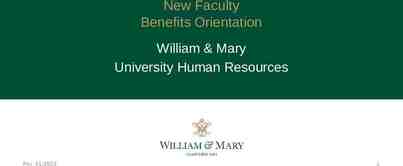Understanding National Science Foundation (NSF) Funding
45 Slides4.40 MB
Understanding National Science Foundation (NSF) Funding Opportunities Susan Winter University of Maryland [email protected] 1
NSF: A Federal Agency “ promote the progress of science advance the national health, prosperity and welfare secure the national defense ” National Science Foundation Act of 1950 All fields of science/engineering Discipline & cross-discipline NOT Medical (NIH) Classified Sources Ideas Science Community Executive Priorities
President’s Science & Technology Priorities for FY2015 Budget Promote Economic Growth/Job Creation Improve Health of All Americans Move toward Clean Energy Address Global Climate Change Manage Environmental Resources Ensure National Security
NSF Facilitates Fund Extramural Research Build Research Workforce Capability Grad and UG, Junior Faculty Workforce Diversity Engage Academic Community Workshops Outreach to General Public Increase International Partnerships Cannot Do Research!
NSF Impact - Annual Budget of over 7.0 Billion - Funding Source for Research by US universities - 20% of all federally supported basic research 80% of basic computer science research - (NSF at a Glance – NSF Home page – FY 2010) 5
NSF Structure National Science Board Comp & Info Sci & Eng Director Deputy Director Social, Behav & Econ Sciences Engineerin g Bio Sciences Office of Internat’l & Integrated Activities GeoSciences Educ & Human Resources Math & Physical Sciences
NSF Process Merit Review for Award Selection Process Criteria Select about 10,000 New Awards Annually About 45,000 Proposals Submitted Credit: Garie Fordyce, National Science Foundation 7
NSF Proposal & Award Process & Timeline Returned As Inappropriate/Withdrawn NSF Announces Opportunity GPG P.A. P.S Org. submits via: FastLane Min. 3 Revs. Req. N S F Mail NSF Prog. Off. Panel Award Prog, Off. Analysis. & Recom. Via DGA DD Concur Both Research & Education Communities Organization Decline Proposal Receipt at NSF 90 Days Proposal Preparation Time DD Concur 6 Months Proposal Receipt to Division Director Concurrence of Program Officer Recommendation Award 30Days DGA Review & Processing of Award
Types of Review ‘Mail’ Reviewers plus Panel Review Panel Review (Standing vs. Ad-Hoc) Internal Review Only Sources of Reviewers: Program Officer’s knowledge References in proposal Web of science; SSRN; Google Scholar, etc. Reviewer recommendations Investigator’s suggestions Volunteers 9
Things to Know About Panels Proposal Pressure Dozens of Proposals 1 ½ Days for Discussion 10% to 20% Funded Write for: Scholar Serving as Lead Will Present Positive and Negative Aspects Another Scholar Serves as Scribe Captures Panel Deliberations Full Panel Who Will Rank All the Proposals PO Who will Consider Panel Discussion and Ranking in Making Funding Recommendation
NSF Merit Review Criteria Intellectual Merit Advancing Knowledge in Some Field of Study Describe How the Project is Specifically Advancing Science by Developing/Testing Novel Theories, Algorithms, Methodology, Instrumentation, Analytic, Visualization, Techniques Broader impacts Benefiting Society – Be specific about Activities! Diversity: Involve, Train, and Mentor Undergrads, Women & Minorities Training Dissemination/Public Awareness/Education and Outreach Infrastructure 11
Merit Review Elements 1. 2. 3. 4. 5. Potential to Advance Knowledge or to Benefit Society Creativity and Originality (“Potentially Transformative”) Sound Plan for Achieving Goals (Including Evaluation of Outcomes) Qualifications of the Proposers Sufficient Access to Resources
Proposal Opportunities Solicited Core Programs Special Solicitations May Cross NSF Boundaries Unsolicited “Dear Colleague” Letters EAGER RAPID Supplements Workshops
Proposal Rules: Grant Proposal Guide Well-Known Lesser Known Submission: Electronic (Fastlane/grants.gov), SRO Role Page Limits, Font Size, Margins, etc. Components: Bio-Sketch, Current & Pending, Data Management Plan, Post-Doc Mentoring Plan, COI Lists Letters: Support vs. Commitment Cost-Sharing Not Allowed List of Potential Reviewers (or Non-Reviewers) IRB Exempt or Approved Solicitation/Program Specific (Read Carefully!) Limits: Proposals per PI or per Institution Requirements for Partnerships Multiple Disciplines, Industry, International Management Plans
Post-Award Annual Reports Due After 9 Months Overdue After 12 Months Block Any Award Actions for You and For Co-PIs Update PO Organize Events to Showcase Research to Academic Audiences Submit “Public Interest” Science Highlights to NSF Acknowledge Awards in Publications and Presentations Start Working on Future Submissions Award Activity and Perf. Eval. (Tenure and Promotion)
Some Tips in Seeking Funding: The Homework Deductive, Top-down Strategy www.nsf.gov Funding Opportunities Find Funding Opportunities How to Prepare Your Proposal Read the Program or Solicitation Description Content vs. Boilerplate Inductive, Bottom-up Strategy Search NSF awards for abstracts Offer to review proposals 16
Some tips in seeking funding Discuss your idea with an NSF PO/PD/PM 1-2 pg written synopsis Need, Work Being Built Upon, Work to be Done, 5-10 Major References Get copies of previously funded proposals Directly from the PI From NSF (FOI: takes much longer)
Institutional Constraints Your Program Officer is Your Best Friend. Like a Journal Editor, but Different POs are Expatriate Scholars Dual Institutional Logics Rotators and Permanent Want to Fund High Quality Research (Academic) that Addresses Program Objectives (Bureaucratic Politics) Funding Rates Vary by Program (Usually 10-30%) Don’t Like Rejecting Quality Proposals Don’t Like Funding Dodgy Proposals Must Spend Out Budget to the Penny Each Year
POs Help Manage Flow of Proposals Pre-submission, your PO stands ready to: Translate the RFP into English Critique your Conceptual 2-pager Offer Developmental Comments Give Candid Advice – Encouragement or Redirection Meet with You in D.C., or at Conferences Suggest Framing
POs Want you to Succeed Post-award, treat your PO like a valued colleague: Communicate Often, Not Just in Annual Reports Ask your PO’s Advice Provide Updates on Progress and Changes Invite your PO to Conference Presentations Based on NSF Awards Ask your PO, What Could I Do That Would Make you a Hero?
Proposal Content Use Language from RFP Criteria as Appropriate Underscore PI Team Prior Collaboration Demonstrates Higher Potential of Success Dispel Suspicion of Shotgun-Marriage of Convenience Leverage/Extend Prior Funded Research Specifically Describe how the Proposed Research Adds Value Above and Beyond Previous Research Clear Roles and Expectations for Personnel Stay within Specified Funding Limit Budget Justification Aligned with Work Plan and Timeline
What’s in the Proposal? Write it Long, Then Tighten It Up Write a Detailed Outline First Tables & Figures for Complex Information Headings/Subheadings; More Structure is Better Must be Self-Explanatory; Reference Them; Use for both Theory & Method Questions you MUST Directly Address: What important problem (scientific, societal) will you work on? How is your team uniquely qualified to work on it? Exactly what “new” work will you do? Include a Gantt Chart; Who Does What, When, Where
Who’s in the Proposal? Match the Ideas & Scope of Work Explain the Alignment in the Proposal Choose Team Carefully Assemble the Smallest Team with all of the Expertise & Resources You Need Multi-Disciplinary/Multi-University vs. SingleDiscipline/Single-University Senior Collaborators: Know How to Manage Funded Research Projects & Research Teams Resources & Infrastructure Can Be co-PIs or Consultants Include Post-doc(s), Graduate Students, Undergraduates
What’s in the Budget? Summer Salary (Up to 2 months) of Faculty Salary (Full or Partial) for Post-Docs, Programmers, Support Staff Stipend & Tuition for PhD Students Travel to Collect Data/Disseminate Findings Equipment and Supplies Overhead
Some Tips in Seeking Funding Find a Partner, Colleague, or Collaborator Get Colleagues to “Pre-Review” your Proposal Collaborate with Previously Successful PI Adding your Dimension to their Work Create Partnership for Interdisciplinary Research Colleague at a Predominantly Undergrad Institution: Submit a RUI Proposal 25
Questions?
Types of Opportunitiess Core Cyber-Human Systems (CHS) CHS supports research on Solicited Creative ideas and novel theories for understanding: Types of Individuals No External Review Innovative technologies for: Large Centers iCorps Human-computer and human-human interactions, collaboration, and competition. Role of computing in how humans communicate, work, learn, and play. Systems that interact with people using various modalities. Computer supported collaboration. Human-Computer and human-robot interactions. Social computing. Affective computing. Universal access. Immersive environments.
Applying to Core Programs Program Solicitations: CCF: NSF 13-579 Coordinated CNS: NSF 13-581 Solicitations IIS: NSF 13-580 Project Types: Large: 1,200,001 to 3,000,000; up to 5 years, collaborative teams Medium: 500,001 to 1,200,000; up to 4 years, multi-investigator teams Small: up to 500,000; up to 3 years, one or two investigator projects CISE-wide Submission Windows: Large: November 4–19, annually Medium: September 24–October 15 (2013 only) Small: January 2–17, annually PI Limit: Participate in no more than 2 “core” proposals/year
SBE Organization 30
Types of Opportunities Unsolicited Solicited Types of Individuals No External Review Large Centers iCorps Key Social, Behavioral and Economics Programs Jan/Feb and Aug/Sept due dates annually Science of Organizations Decision, Risk & Management Science Economics Law and Social Science Methodology, Measurement & Statistics Social Psychology Sociology Science, Technology & Society Geography and Spatial Sciences Sept due date annually Science of Science and Innovation Policy 31
Types of Opportunities Unsolicited Solicited Types of Individuals No External Review Example Standing Opportunities in Other Directorates ENG Service Enterprise Systems (SES) Systems Science (SYS) Infrastructure Management and Extreme Events (IMEE) Large Centers iCorps 32
Types of Opportunities Unsolicited Solicited Types of Individuals No External Review Large Centers iCorps Promising Current Solicitations for Management Scholars Building Community and Capacity for DataIntensive Research in the Social, Behavioral and Economic and in Education and Human Resources Catalyzing New International Collaborations (contact the country expert in OISE) Science, Engineering and Education for Sustainability Research Coordination Networks Science Across Virtual Institutes 33
Sample of CISE Cross-Cutting Programs Types of Opportunities Unsolicited Cross-Directorate Cyberlearning: Transforming Education (CTE) Designing and implementing technologies to aid and understand learning. Solicited Types of Individuals Secure and Trustworthy Cyberspace (SaTC) Securing our Nation’s cyberspace from malicious behavior, while preserving privacy and promoting usability. Cross-Agency Smart and Connected Health (SCH) Transforming healthcare knowledge and delivery, and improving quality of life through IT. No External Review Developing tools to manage and analyze data in order to extract knowledge from data. Large Centers iCorps Core Techniques and Technologies for Advancing Big Data Science & Engineering (BIG DATA) National Robotics Initiative (NRI) Developing and using robots that work alongside, or cooperatively with, people .
Types of Opportunities Unsolicited Solicited Types of Individuals No External Review Large Centers iCorps Grants for Particular Types of Individuals Graduate Research Fellowships Doctoral Dissertation Improvement Grants (in SBE) SBE Postdoctoral Research Fellowship Program CAREER Awards 35
Types of Opportunities Faculty Early Career Development (CAREER) Program Unsolicited Solicited Types of Individuals No External Review Large Centers iCorps The NSF’s most prestigious awards in support of junior faculty who exemplify the role of teacher-scholars through: outstanding research, excellent education, and the integration of education and research within the context of the mission of their organizations.
Types of Opportunities Grants with Only Internal Review Unsolicited RAPIDs: Grants for Rapid Response Research Solicited EAGERs: Early concept Grants for Exploratory Research Types of Individuals No External Review Large Centers INSPIREs: Integrated NSF Support Promoting Interdisciplinary Research and Education Workshops, doctoral consortia REU Supplements iCorps 37
Types of Opportunities Large Center Opportunities Unsolicited Solicited Types of Individuals No External Review Large Centers iCorps Science and Technology Centers: Integrative Partnerships (STC) Industry & University Cooperative Research Program (I/UCRC) ADVANCE: Increasing the Participation and Advancement of Women in Academic Science and Engineering Careers (ADVANCE) 38
Types of Opportunities NSF Innovation Corps (I-Corps) Unsolicited Solicited Types of Individuals No External Review Supplements to current or recently expired NSF grants to catalyze commercialization of research products. Involves mentoring and funding to develop commercialization options The lead can be a student Large Centers iCorps Building capacity and capability for the long run. 39
Finding information: http://www.nsf.gov
Funding opportunities Upcoming Due Dates
Subscribe to updates Get NSF Updates by Email
CISE Updates and Announcements: http://www.cise.nsf.gov New information Get CISE Updates by Email Featured Programs Subscribe to receive special CISE announcements
Search awards from each program page 44
Award search results


















































